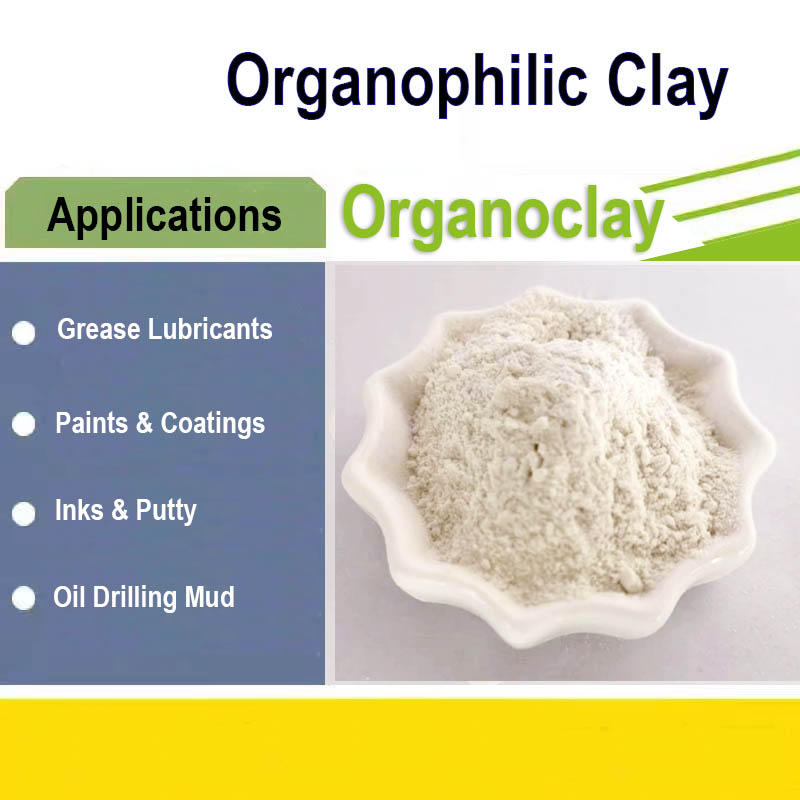Sinteza organoklina
Prije nego što pređemo na detalje reološkog aditiva od organokline, prvo saznajmo kako se sintetizira. Proces sinteze uključuje modificiranje površine čestica bentonita organskim spojevima, tipično kvaterne amonijeve soli. Ovi organski spojevi pažljivo su odabrani kako bi se osigurala kompatibilnost sa željenom primjenom i kako bi se postigla specifična svojstva rada. Modifikacija površine povećava disperzibilnost gline u različitim matricama, kao što su polimeri, premazi, tekućine za bušenje, i druge industrijske formulacije.
Njegova sinteza započinje procesom interkalacije, gdje su organski spojevi umetnuti između slojeva strukture montmorillonita ili bentonita. To se obično postiže reakcijama razmjene iona, gdje su kationi prisutni u rešetki gline zamijenjeni organskim kationima. Izbor organskih kationa ovisi o željenim svojstvima reološkog aditiva organoklay, poput željenog reološkog ponašanja, Kompatibilnost sa sustavom domaćina, i temperaturna stabilnost. Modificirana glina je podvrgnuta dodatnim koracima obrade, kao što je sušenje, mljevenje, i mljevenje, Da biste dobili fino raspršeni organoclay prah, koji se može koristiti kao organoclay reološki aditiv.
Površinska modifikacija minerala gline
Površinska modifikacija minerala gline poput bentonita događa se iz dva razloga. Jedna je fizička adsorpcija, koji uključuju pričvršćivanje polimera na površinu minerala gline kroz nekovalentne interakcije. Polimeri se obično otopljeni ili raspršuju u otapalu, a zatim pomiješaju s mineralima gline bentonita, omogućavajući polimernim lancima da se pridržavaju glinenih površina.
Kemijsko cijepljenje uključuje kovalentno vezivanje funkcionalnih polimera na površine minerala bentonitne gline, tvoreći jaču i stalniju pričvršćivanje. Ovaj pristup često zahtijeva kemijsku reakciju između glinenih površina i polimernih molekula.
Reakcija se može postići metodama poput esterifikacije, amidacija, ili reakcije kondenzacije. Funkcionalne skupine prisutne na polimernim lancima reagiraju s površinskim hidroksilnim skupinama minerala gline, stvaranje kovalentne veze.
Površinska modifikacija glinenih minerala putem fizičke adsorpcije ili kemijskog cijepljenja polimera stvara reološke aditive organske gline. Ovi aditivi su oni koji se koriste u tolikom broju industrija da daju reološke mogućnosti formulaciji proizvoda.
Modifikator reologije (Organoclay Reološki dodatak)
Modifikator reologije također se može nazvati reološkim aditivom. Ovi aditivi mijenjaju reološka svojstva materijala. Oni su ugrađeni u formulacije za povećanje viskoznosti i kontrolu svojstava i karakteristika gotovog proizvoda, obično u industriji naftnih polja ili boja, proizvodnja boja i premaza.
Modifikator reologije Bentonit Organoclay
Organocline reološki dodaci koji se temelje na bentonitnim glinama imaju puno korisnih svojstava. Povećava viskoznost formulacije, čineći ga debljim i otpornijim na protok. Obično se koriste u proizvodima kao što su boje, ljepila, premazi.
Reološki aditivi od organske gline također se mogu koristiti kao tiksotropni modifikatori koji mogu pokazati smanjenje viskoznosti pod smičnim naprezanjem i oporavak viskoznosti kada se naprezanje ukloni. Ovo ponašanje omogućuje lakšu primjenu i širenje proizvoda uz održavanje stabilnosti kada miruje. Također pomaže spriječiti opuštanje ili kapanje formulacije kada se nanosi okomito ili na nagnute površine. Također utječe na ponašanje tečenja materijala, poboljšanje njegove nivelacije, vlaženje, ili karakteristike prskanja.
Reološka svojstva mješavina glinenih suspenzija paligorskit-bentonit i sepiolit-bentonit
Ponekad, Organoclay reološki dodaci nastaju miješanjem minerala gline s bentonitnom glinom. Kombinacija paligorskita ili sepiolita s bentonitom u glinenim suspenzijama rezultira poboljšanim reološkim svojstvima, uključujući poboljšanu stabilnost, kontrolirana viskoznost, otpor sag, i tiksotropno ponašanje.
paligorskit
Paligorskit je vlaknasti glineni mineral koji ima jedinstvenu kristalnu strukturu. Sastoji se od dugih, tanak, igličasti kristali koji su međusobno isprepleteni, tvoreći trodimenzionalnu mrežu. Ova struktura pridonosi karakterističnim svojstvima paligorskitne gline.
Kombinacija minerala paligorskita i smektita posjeduje adsorpcijske sposobnosti paligorskita i svojstva bubrenja i koloida smektitnih glina poput bentonita. Ova kombinacija rezultira da atapulgitne gline imaju izvrsnu svojstva apsorpcije vode i zadržavanja, visoka površina, i dobra disperzibilnost u sustavima na vodi.
Sepiolit
Još jedan mineral vlaknastih glina koji je usko povezan s Palygorskiteom. Značajne prednosti suspenzija sepiolita su njihova stabilnost, Čak i u sustavima s visokim udjelom soli i visokom ionskom čvrstoćom. Za razliku od suspenzija drugih glina, kao što je bentonit, Suspenzije sepiolita održavaju svoju stabilnost i performanse u izazovnim uvjetima. Ova se stabilnost pripisuje jedinstvenoj strukturi i površinskim svojstvima sepiolita, koji mu omogućuju da se odupre učincima visokih koncentracija soli i ionskih interakcija.
Miješanjem sepiolita s bentonitom, Može se postići sinergistički učinak, što rezultira vrhunskim proizvodom. Sepiolit poboljšava svojstva bentonita pružajući dodatnu stabilnost, poboljšano tiksotropno ponašanje, i kontrola nad reološkim svojstvima rezultirajuće smjese. Kombinacija sepiolita i bentonita stvara vrlo učinkovit reološki aditiv organoklay.
Karakterizacija anion -karcionalnih površinski aktivnih tvari modificirana Montmorillonit
Kationski površinski aktivni tvari su tvari koje nose pozitivne naboje i mogu se učinkovito adsorbirati na materijale koji posjeduju negativne naboje kroz snažne elektrostatičke ili interakcije naboja naboja. Montmorillonit je vrsta glinenog minerala sa slojevitom strukturom, koji se sastoje od složenih listova. Kad se montmorillonit modificira s kationskim površinski aktivnim tvarima, Molekule surfaktanata adsorbiraju se na površinu gline, Promjena njegovih svojstava i poboljšanje njegovih performansi.
Modifikacija montmorillonita s kationskim površinski aktivnim tvarima dovodi do stvaranja organoklara reološkog aditiva. Ovaj pokazuje poboljšana svojstva u usporedbi s netaknutom glinom koja se koristi kao reološki aditiv. Ove modificirane gline smatraju se visoko učinkovitim apsorbentima zbog povećane površine, Poboljšani afinitet prema organskim spojevima, i poboljšani adsorpcijski kapacitet.
Reologija disperzija natrija i kalcija bentonita-vode
Dok i disperzije natrijevog i kalcijevog bentonita pokazuju tiksotropno ponašanje, Postoji značajna razlika u stupnju tiksotropije između njih dvojice. Natrijev bentonit obično pokazuje veći stupanj tiksotropije u usporedbi s kalcijevim bentonitom. Thiksotropija koju je izložio natrijev bentonit može biti dva reda veće od one kalcijevog bentonita.
Viši stupanj tiksotropije uočen u disperzijama natrijevog bentonita i vode može se pripisati jedinstvenim svojstvima natrijevih iona. Ioni natrija imaju manju veličinu i veću gustoću naboja u usporedbi s ionima kalcija. Ova svojstva omogućuju ionima natrija da stvore jaču elektrostatsku interakciju s česticama gline, što dovodi do povećanog strukturnog preuređivanja i ponašanja pri smicanju.
Disperzije kalcijevog bentonita i vode i dalje pokazuju tiksotropno ponašanje, ali u manjoj mjeri. Veća veličina i niža gustoća naboja iona kalcija rezultiraju slabijim interakcijama s česticama gline, što dovodi do nižih razina strukturnog preuređivanja i stanjivanja smicanja.
Kontrola svojstava isplake za bušenje na bazi bentonita
Kontroliranje svojstava blata za bušenje na bazi bentonita presudno je za uspješne operacije bušenja. Dodavanje sepiolitnih nanočestica u saljinu i svježu bušenje na bazi bentonita može značajno poboljšati plastičnu viskoznost i točku prinosa. Plastična viskoznost odnosi se na otpornost na protok, dok točka prinosa predstavlja minimalni napon potreban za pokretanje protoka. Poboljšanjem ovih svojstava, sepiolitne nanočestice pomažu u održavanju stabilnog i upravljačkog protoka blata.
Prednost uključivanja sepiolitnih nanočestica je poboljšana stabilnost reoloških svojstava blata u širokom rasponu temperature i tlačnih uvjeta. To je posebno presudno pri visokim temperaturama i pritiscima, gdje održavanje željenih karakteristika protoka postaje izazovnije. Sepiolitske nanočestice pomažu u sprječavanju nepoželjnih promjena u reološkom ponašanju blata, Osiguravanje dosljednih performansi tijekom operacija bušenja.
Organoclay reološki aditivi sa sepiolitnim nanočesticama imaju pozitivan utjecaj na smanjenje gubitka tekućine i propusnost pri tlaku i temperaturama rezervoara. Gubitak tekućine odnosi se na gubitak bušenja blata u formiranje tijekom bušenja, što može dovesti do različitih problema poput oštećenja formiranja i smanjene učinkovitosti bušenja. Sepiolitne nanočestice učinkovito smanjuju gubitak tekućine i minimiziraju smanjenje propusnosti, Pomaganje u održavanju stabilnosti i integriteta bušenja tekućine.
Učinci ugljičnog pepela na reološka svojstva tekućine za bušenje na bazi vode
Kada se ugljični pepeo uvede u disperziju bentonita, zajedno s komercijalnim reološkim modifikatorom, Značajne promjene događaju se u reološkom ponašanju tekućine za bušenje. Jedan od istaknutih učinaka je značajno poboljšanje točke prinosa, posebno za male čvrste dispekzije bentonita.
Točka prinosa tekućine za bušenje predstavlja minimalni napon potreban za tekućinu da počne teći. Uključivanjem ugljičnog pepela u disperziju bentonita, Točka prinosa je primjetno poboljšana, što ukazuje na poboljšane performanse tekućine i stabilnost. Ovo poboljšanje postaje još izraženije kada je čvrsti sadržaj disperzije bentonita nizak.
Pored poboljšane točke prinosa, Ostala reološka svojstva disperzije bentonita, poput plastične viskoznosti i čvrstoće gela, također može doživjeti pozitivne učinke od prisutnosti ugljičnog pepela. Ova svojstva utječu na ponašanje protoka tekućine i njegovu sposobnost obustave i transporta reznica bušenja.
Organoclay Reološki aditivni utjecaj na temperaturu visoke temperature visoke tlaka volumetrijskih svojstava tekućine na bazi ulja
Utjecaj organoklay reološkog aditiva na visoku temperaturnu svojstva visokih tlačnih temperaturnih svojstava tekućine za bušenje u nafti od velike je važnosti u naftnoj i plinskoj industriji. Suspenzije organoclay pokazuju odnos za temperaturu gustoće sličan onome za bušenje na bazi sintetičkih ulja, čineći ih prikladnim za upotrebu kao reološki aditivi u takvim sustavima.
Kada se organoclay doda kao reološki dodatak tekućini tekućine na bazi ulja, Značajno povećanje vrijednosti gustoće primjećuje se u cijelom rasponu temperature i tlaka. Ovo povećanje gustoće ukazuje da organoklay povećava ukupnu gustoću sustava tekućine za bušenje. Učinak zgušnice pripisuje se ugradnji čestica organokla i njihovoj interakciji s fluidnom matricom.
Na ekspanzivno volumetrijsko ponašanje suspenzija organoklata značajno utječe priroda samog organoklaja. Različite vrste organoklaja mogu pokazati različite stupnjeve volumetrijske ekspanzije. Međutim, Kako se pritisak povećava, Ekspanzivno ponašanje je prigušeno. Povećanje tlaka djeluje na uravnoteženje volumetrijskog ekspanzije, što dovodi do kontroliranijeg i stabilnog sustava.


